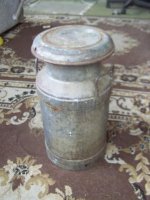cussedemgun
Member
Now the rest of the story -
We're talking pre-stainless, they used an alloy they called (wah-lah) dairy metal. It was a nickel bronze alloy & used primarily for cast or machined parts including piping. I believe that bucket will be nickel plated.
In the '50s the dairy industry was changing from hand milking to milking machines, pipeline operations & refrigerated bulk tanks. I don't know how old that bucket would be but it's safe to say it's pre-ww II.
Same era as this cream can, milk was usually filtered, cooled by running over a cold water tube cooler & transferred to cans. The cans were stored/held for shipment in a cold water tank. 5 & 10 gal. cans were common, the small ones were commonly called cream cans, the larger were milk cans. Pre WWII most milk transport from farm to creamery was by railroad. Thus, the local run that stops at all stations, be it train, bus, or plane is still called "the milk run"
In western Washington is a town by name of Tenino (my sister has lived there for many years). It got it's name from the milk platform by the railroad tracks, #290.
Clean it up and you will find that its stainless steel. The dairy indistry was one of the first industries to use stainless steel.
We're talking pre-stainless, they used an alloy they called (wah-lah) dairy metal. It was a nickel bronze alloy & used primarily for cast or machined parts including piping. I believe that bucket will be nickel plated.
In the '50s the dairy industry was changing from hand milking to milking machines, pipeline operations & refrigerated bulk tanks. I don't know how old that bucket would be but it's safe to say it's pre-ww II.
Same era as this cream can, milk was usually filtered, cooled by running over a cold water tube cooler & transferred to cans. The cans were stored/held for shipment in a cold water tank. 5 & 10 gal. cans were common, the small ones were commonly called cream cans, the larger were milk cans. Pre WWII most milk transport from farm to creamery was by railroad. Thus, the local run that stops at all stations, be it train, bus, or plane is still called "the milk run"
In western Washington is a town by name of Tenino (my sister has lived there for many years). It got it's name from the milk platform by the railroad tracks, #290.


